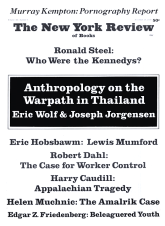In response to:
Hyperkinetic Children from the October 22, 1970 issue
To the Editors:
In the colloquy between Dr. Carlos Carrillo and John Holt in the Letters column of October 22, both have overlooked the critical issues concerning hyperkinetic children. The syndrome is not new, nor is the treatment with amphetamines which was begun by Dr. Charles Bradley over thirty years ago. What is new is that diagnosis and treatment of “hyperactivity,” “hyperkinesis,” “minimal brain dysfunction,” etc., are rapidly spreading throughout the public school systems of the country. Moreover, the diagnosis is frequently being made by teachers and school nurses and treatment most often administered by family GPs with the consent of parents who remain largely unaware of the complex psychiatric and neurological examinations required before the condition may be accurately diagnosed.
Psychiatrists estimate that hyperkinesis is prevalent in perhaps 4 percent of all elementary schoolchildren, yet educators have estimated the number at 15 to 20 percent. The implications of such a wide divergence of opinion are frightening. In Omaha, for example, 5 to 10 percent of the 62,000 schoolchildren are taking “behavior modification” drugs prescribed by local doctors to improve classroom deportment and increase learning potential. (Two of the five drugs in use have just been declared “dangerous” by the FDA.) Dr. Edward Sewell, Director of Health Services of the School District of Philadelphia, has acknowledged that the drugs are in use within the Philadelphia system. Studies in the psychiatric journals point not only to the difficulty of diagnosis, but also to the importance of psychotherapy and remedial education, in addition to the treatment with amphetamines, particularly since the later serve only to mask the symptoms which reappear when treatment is diminished.
Amphetamines are tricky business. No one understands how or why they work on hyperkinetics. Sometimes they don’t work at all. Sometimes they cause serious side effects. In Canada in 1967, Dr. Philip Ney wrote of a hyperkinetic eight-year-old boy who developed an amphetamine psychosis as a result of treatment with the drug for the hyperkinetic syndrome. In the Journal of the American Medical Association, Dr. J. Gordon Millichap has cautioned against “the use of the central nervous system stimulants and mood-modifying agents for prolonged periods” with hyperkinetic children. Since the syndrome generally disappears in adolescence, with or without treatment, there has been almost no followup of patients once normalcy has been achieved. Finally, there have been no studies made on the long-range effects of the administration of amphetamines to children.
What Dr. Carrillo and John Holt should both be concerned with…what we should all be concerned with…is that hyperkinetic children be assured of adequate psychiatric diagnosis and treatment, and that normal children with similar symptoms not be victimized by overzealous educators in their mad dash for classroom deportment.
M. Yanow
Narberth, Pennsylvania
This Issue
November 19, 1970



